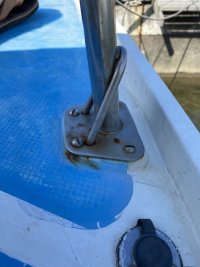Hawaii Sailor
E27, Kaneohe, Hawaii
I was gifted bigger stanchions that I will be replacing around the boat (not pictured here). The bases of the new stanchions are bigger than the original fiberglass molded raised stanchion base. Would you recommend I build up the stanchion base with epoxy to fit the new stanchion? Or is it possible to grind it flat to be flush with the deck? I believe the purpose of the raised fiberglass stanchion base is to prevent water intrusion and make a proper angle of the stanchion. Many boats have the stanchion bolted flush with the deck. I will also be re-coring the deck under the stanchions and installing backing plates from inside the boat.


